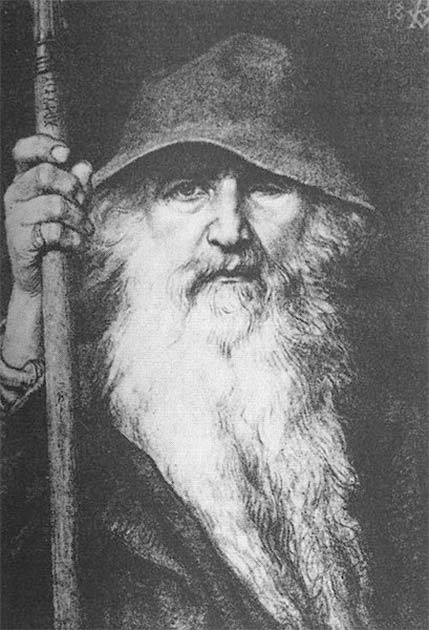Woden, derived from Odin in Norse mythology, was one of the most important gods in Anglo-Saxon mythology. He was the god of war, wisdom, and poetry, and he played a significant role in the Anglo-Saxon culture as well as the culture of the Vikings.
Woden however is different. He has two eyes, for a start, and other features about his characterization do not match his Norse prototype. This is some distinct, specifically Anglo-Saxon god, and his story appears to be his own.
Unfortunately no detailed account of Woden and his mythical adventures survives, and some have debated if he was even a god. The earliest English chronicles from the 8th, 9th, and 10th centuries claim he was the father of the Anglo-Saxon peoples.
But despite this, Woden was still discussed in the 11th century after the Norman Conquest. This article will explore the origins of Woden, his significance in mythology, and the decline of his worship among the Anglo-Saxon peoples.
Woden
Woden was a powerful god in Anglo-Saxon mythology, worshipped by the people for centuries. He was known for his wisdom, poetry, and his role as the god of war. Woden’s name is derived from the Proto-Germanic word Wōdanaz, which means “fury” or “raging”.
He was originally a god in the Germanic pantheon, and his name was later adopted by the Norse people. Woden was associated with other gods, such as Tiwaz (who also has a Norse analogue, Tyr), who was the god of war and justice, and Thor (no explanation needed), who was the god of thunder and strength.

Woden was also associated with the goddess Frigg, who was his wife and the goddess of love and fertility. Wednesday is drawn from his name and through this he has even been associated with the Roman God Mercury.
In the Norse pantheon, Odin (Woden) was the chief god and the ruler of Asgard, the home of the gods. Equally, he was known for his wisdom and his ability to see into the future. In Norse mythology though Odin was also associated with death and the afterlife, as he was said to lead the souls of the dead to Valhalla, the hall of the slain.
The earliest written record of Woden is found in a runic inscription of a 7th-century brooch located in southern Germany. His next mention comes from Bede in the 8th century where he is claimed to have been the father of the Anglo-Saxons, whereas Paul the Deacon claims that Woden is worshiped by all the nations of Germania.
His name can be seen across the landscape in modern England. Places such as Wednesbury, Woodnesborough, and Wednesfield all indicate a link to Woden. There were likely many more, but older names have been lost in the record.
There was a clear link between Woden and the kings and warlords of the time. As the “father of the Anglo-Saxon people” he was associated with leaders who had success on the battlefield and in the mead hall. Early leaders in Anglo-Saxon history were also priests and would converse with gods on behalf of their people. It created a sacred nature to early leadership and kingship.
The Norse Original
Woden obviously derived from Odin, and many characteristics survived the transition. Odin played a significant role in Norse culture of his ability to inspire warriors and poets alike, and he was often depicted as an old man with a long beard and a wide-brimmed hat.
Odin was also associated with magic and sorcery, as he was said to have learned the secrets of the universe by hanging himself from the world tree, Yggdrasil, for nine days and nights. It was because of this that he was an important figure in Viking culture because he embodied the values of courage, wisdom, and strength. He was worshipped by warriors and poets alike, and his influence can be seen in many aspects of Viking society, such as art, literature, and religion.

Despite his popularity among the Anglo-Saxons and their Viking forebears, Woden’s worship began to decline in the 10th century. This was due in part to the rise of Christianity in the Viking world, as many people began to convert to the new religion and the conversion of the Anglo-Saxon people to Christianity in the early 8th century.
- The Legendary Geats: What Happened to Beowulf’s People?
- Thick Skinned: Why Did Vikings Really Cover Their Shields with Leather?
Christianity offered a different set of values and beliefs than those of Woden and the other Norse gods, and many people found it more appealing as it was less focused on war and more on forgiveness and clemency. Though this was not an easy transition.
The Norse were originally willing to accept Jesus and God as another deity to add to their pantheon. However, this was not acceptable to the Christian Church. The priests and rulers of Christianity claimed that these new Gods could offer them something that their old gods could not: divine salvation and an eternal home in heaven. In addition to this, Christianity was becoming the political norm across Europe.
The other important factor that contributed to Woden’s decline in worship was the increasing centralization of power among Viking rulers and those of the Anglo-Saxon nations. As the Viking world became more unified in Denmark, Sweden, and Norway, the role of local gods and goddesses became less important.

Whilst many would still worship in private to their old gods, many happily converted to a religion that offered them more. Woden, as the chief god, was seen as a symbol of the old ways, and his influence began to wane. Equally with the creation of England, and the adoption of Christianity, Woden became less and less popular especially as the ruling monarchy of England had chosen Christianity as the ruling faith.
Woden was nonetheless a powerful god in Anglo-Saxon and Norse mythology, worshipped by both people for centuries. He played a significant role in their culture, embodying the values of courage, wisdom, and strength.
Whilst not much evidence is known for his origin, Woden/Odin has been pieced together from the later chronicles. One community, however, retained its knowledge of Woden until the 18th century.
The Sami People were so isolated in Northern Scandinavia that Christianity never thrived there. Unfortunately, a Christian missionary eventually came in 1720 to convert them but burning their sacred sites was an item. A loss to the final stronghold of Woden.
Top Image: Woden is obviously based on the Norse god Odin, and yet he has notable differences. Source: Historia n°762 / Public Domain.
By Kurt Readman